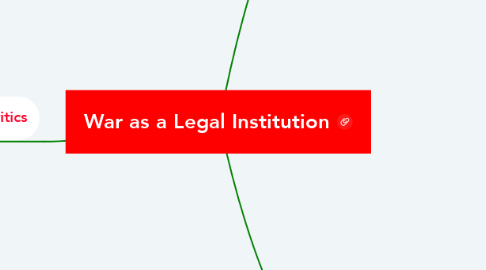
1. Critics
1.1. About the news: Turkey
1.1.1. UNSC suggest an intervention = refused by veto
1.1.2. Implicit agreement for Turkey by USA armies quitting the borders
1.1.3. Pression by european States is impossible
1.1.3.1. Terrorism and immigration issues (currently managing by Turkey)
1.2. UNSC
1.2.1. Lack of efficiency
1.2.1.1. Veto right problem
1.2.1.1.1. Unadapted for the new conflicts
1.3. Unadapted laws of war
1.3.1. Emergence of new actors and war models
1.3.1.1. Universality of the jus ad bellum and jus in bello?
2. Theories
2.1. Jus ad Bellum
2.1.1. UN Charter (26/06/1945)
2.1.1.1. Prohibit wars (ART 2§4 UN Charter)
2.1.1.2. First exception : UNSC (ART 39 and 42 UN CHARTER
2.1.1.2.1. A priori control
2.1.1.3. Second exception: Self-defence (current or imminent attack; the necessity of the use of force; the proportionality of the use of force)
2.1.1.3.1. A posteriori control
2.2. Jus in Bello
2.2.1. Geneva Convention of 1949 and its additional protocols
2.2.1.1. International Humanitarian Law
2.2.1.2. Legal protection of the combattants
2.2.1.3. Prohibition of killing civilians
2.2.1.3.1. Exceptions: killing tolerated if the operation respect:
2.2.1.3.2. the principle of proportionality
2.2.1.3.3. the principle of necessity
3. Evolution
3.1. Apparition of the laws of war
3.1.1. Origin : Battle of Solferino
3.1.1.1. Geneva Convetion adopted by 12 states
3.1.1.2. Creation of the International Committee of a Red Cross
3.1.2. Six principles for the ongoing conflicts
3.1.2.1. No targeting civilians
3.1.2.2. No torture or inhumane treatment of detainees
3.1.2.3. No attacking hospitals and aid workers
3.1.2.4. Provide safe passage for civilians to flee
3.1.2.5. Provide access to humanitarian organizations
3.1.2.6. No unnecessary or excessive loss and suffering
3.2. Changements brings by the apparition of new weapons
3.2.1. First World War
3.2.1.1. Technology: mustard gas
3.2.1.2. Creation of the league nation (1919)
3.2.1.3. Versailles Treaty (1919) about the prohibition of gas as weapon
3.2.1.4. Chemical Weapon treaty (1993)
3.2.2. Second World War
3.2.2.1. Technologies: nuclear weapons and Zyclon B
3.2.2.1.1. Nuclear Weapons made at least 300 000 dead
3.2.2.1.2. About 6 millions of jewish were killed during the Second World War (and other minorities were also targeted)
3.2.2.2. Creation of the United Nations (1945)
3.2.2.3. NPT - Non-proliferation Treaty (1970) about nuclear weapon
3.3. Emergence of new models of war
3.3.1. Emergence of new parties
3.3.2. Emergence of new types of conflicts (cyberwar/space wars)

